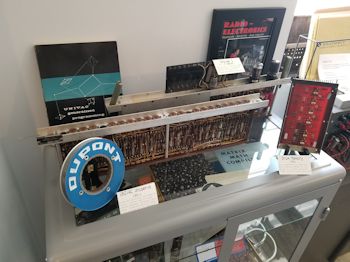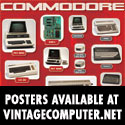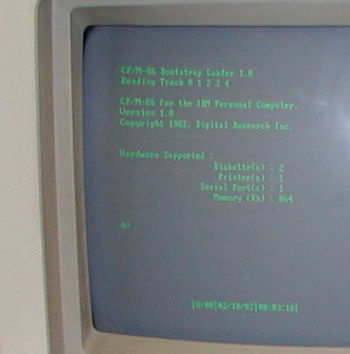UNIVAC 1 and UNIVAC File Computer 1
SHARE |
|
  UNIVAC 1 and UNIVAC File Computer 1
UNIVAC 1 and UNIVAC File Computer 1 |
by Bill Degnan - 08/04/2021 10:22 |
 The two long modules in the back are from a UNIVAC 1 that was located in New York State. The UNISERVO tape is from DuPont and the drum memory component is from a UNIVAC File Computer Model 1. Click on image for larger view.
To see more photos of the UNIVAC I and UNIVAC I File Server components stop by Kennett Classic or click here. See page 34 of http://www.bitsavers.org...enance_Manual_Jan58.pdf Reply |
|
  UNIVAC 60 / 120 modules and 5823 tubes
UNIVAC 60 / 120 modules and 5823 tubes |
by Bill Degnan - 08/23/2021 09:54 |
|
I asked my friend Herb Johnson if he had any 5823 tubes to populate the module with the 35 empty tube slots. He sent me the following reply regarding the use of 5823 tubes in a UNIVAC computer of the era.
"... http://www.bitsavers.org...0_Service_Manual_21.pdf http://www.bitsavers.org...0_Service_Manual_21.pdf http://www.bitsavers.org...0_Service_Manual_21.pdf http://www.bitsavers.org...0_Service_Manual_21.pdf PDF page 227, which is "plate 9C", shows a Thyratron circuit with a 5823. This is the "storage bit controls". The components in the stage shown, very roughly correspond to the components I see in the chassis. A note in plate 9c says "all components shown are in storage 'bit' cage type STB-1" Figure C11 on page C-20 PDF page 62, notes "block schematic examples" and a block with a "T" in the upper left means "thyratron tube is used". PDF page 228 plate 10C shows a 5823 with various dual-triodes for "storage control". I search back for "storage bit" and find PDF page 84, page C-42 "storage" which references plate 9C. "12 independent storage units, each has the capacity of a 10 digit number and its sign. Each digit requires 5 storage bits." The Storage Bit employs the Type 5823 cold-cathode glow-discharge triode. [This is what RCA also calls its 5823.] https://frank.pocnet.net/sheets/049/5/5823.pdf https://frank.pocnet.net/sheets/049/5/5823.pdf https://frank.pocnet.net/sheets/049/5/5823.pdf https://frank.pocnet.net/sheets/049/5/5823.pdf plate 46C, PDF page 264, may be relevant. (-) storage bit operation. So: 5 bits (5 tubes) per digit; 10 digits; that's 50 tubes. the sign bit should only require one tube. So that's 51 tubes per storage unit. The chassis has 35 tubes, so you'd need two chassis per storage unit. SInce there are 12 storage units, that's 24 chassis. I have not seen documentation that says your module or chassis of 35 tubes, is part of the Univac 60 or Univac 120. However those models use the 5823 tube as a storage unit and says it uses five storage bits per digit. If Univac used your module in that fashion, 35/5 = 7 digits, which would hold a decimal number up to almost 10 million. One can do accounting on a 7 digit computer. Bill, the Hagley Library once again appears. https://hagley-aspace-pd...zonaws.com/1985.261.pdf https://hagley-aspace-pd...zonaws.com/1985.261.pdf https://hagley-aspace-pd...zonaws.com/1985.261.pdf https://hagley-aspace-pd...zonaws.com/1985.261.pdf And that schematic fragment I found; Bill you ought to be able to identify the components attached to one tube - call it a "stage of the chassis" - and then see if the schematic matches the component connections. I see so much duplication of components and layout, I think it's likely you'll get a good result. Also: read the Univac document more carefully than I, to get the nomenclature correct. Univac has it's own designations for these circuits and that chassis and that tube - you should use those. OK? Thanks for the opportunity to do some vacuum-tube logic work. This was probably built about the time I was *born* so it's pretty far back. I don't know if you can find any components with dates on them. This artifact looks so weathered and beaten, it's hard to read it at all. It's your call whether to clean it up, or clean up say one "stage" for interpretation and display. ..." More to come. Reply |
|
Resources:

Popular Topics and FAQs
Past Issues:
Before we switched over to a blog format, past page archives here:
Vintage Computer Festival East 3.0 June 2006
Commodore B Series Prototypes July 2006
VOLSCAN - The first desktop computer with a GUI? Oct 2006
ROBOTS! - Will Robots Take Over? Nov 2006
Magnavox Mystery - a Computer, or? Jan 2007
The 1973 Williams Paddle Ball Arcade Computer Game Feb 2007
The Sperry UNIVAC 1219 Military Computer May 2007
VCF East 2007 - PET 30th Anniversary June/July 2007
The Electronic Brain August 2007
Community Memory and The People's Computer Company October 2007
Charles Babbage's Calculating Machine December 2007
Vintage Computing - A 1983 Perspective February 2008
Laptops and Portables May 2008
From Giant Brains to Hobby Computers - 1957 to 1977 August 2008
Historic Computer Magazines November 2008
World's Smallest Electronic Brain - Simon (1950) December 2008 - Feb 2009
Free Program Listings Spring 2009
Computer Music Summer 2009
Popular Electronics Jan/Feb 1975 - Altair 8800 Fall 2009
Early Microcomputer Mass Storage Summer 2010
Degnan exhibit IBM 5150 CPM

This image was selected at random from the archive. Click image for more photos and files from this set.